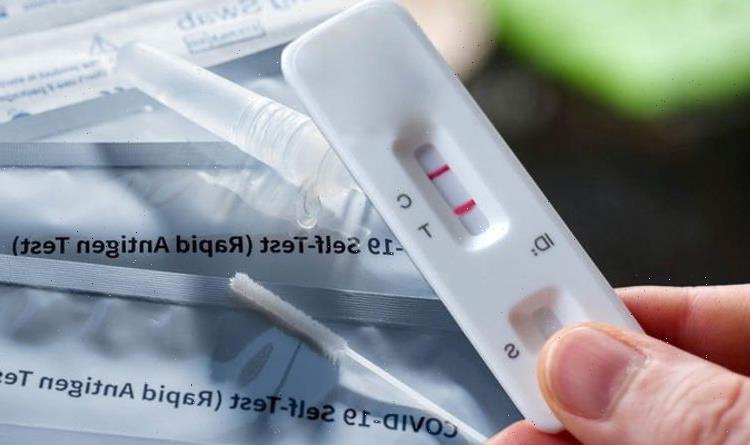Covid passports: Dr Khan on 'accuracy' of lateral flow test
We use your sign-up to provide content in ways you’ve consented to and to improve our understanding of you. This may include adverts from us and 3rd parties based on our understanding. You can unsubscribe at any time. More info
Coronavirus home-testing has become a part of everyday life for people across the UK as cases of Omicron continue to rise. While a singular line on a lateral flow test is often the sign of a negative result, a double line could indicate the presence of COVID-19. Faint lines can be confusing to interpret – but what do they really mean?
The Omicron variant of coronavirus is continuing to spread across the UK forcing billions of Brits into self-isolation.
Recent changes to the self-isolation period saw the 10-day stay at home order reduced to just seven days on the condition of two negative lateral flow tests.
According to gov.uk: “It is now possible to end self-isolation after seven days, following two negative lateral flow device (LFD) tests taken 24 hours apart.
“The first LFD test should not be taken before the sixth day.”
With rapid testing being the first point of call for many concerned Brits, confusing results are becoming more common across the nation.
READ MORE: Omicron variant symptoms: The ‘surprise’ sign appearing when eating


What does a faint line mean on a lateral flow test?
While lateral flow tests are quick and easy to do, multiple tests can produce conflicting results indicating everything from a negative to a positive reading.
After following the instructions on your LFD test kit, the test should present a line next to the ‘C’ on the test to indicate the test has worked.
When a second line appears next to the ‘T’, this indicates a positive Covid reading.
When reading lateral flow test results, two lines through both the ‘C’ and ‘T’, even faint lines, indicate the test is positive, says a Public Health England spokesperson.
However, a ‘T’ line alone indicates the test has failed and will need to be retaken.

What to do if you have a faint positive on a lateral flow test
An A&E doctor who took to his Instagram page has revealed his own medical guidance on the reliability of a lateral flow test.
Dr Nathan Hudson-Peacock explained to his followers: “You do a lateral flow test (LFT, aka rapid antigen test), and it shows a very faint line next to the T.
“What does this mean? Note: regardless of the LFT result, if you are symptomatic, you should isolate and book a PCR.”
If the line appears outside of the 30 minute interpretation window (after you have completed the test), you should not count this as a positive result.
According to latest Government guidance, PCR tests should not be routinely booked by those who test positive on a lateral flow device.
Instead, you should complete another LFT and isolate immediately if it produces another positive result.
DON’T MISS:
PCR test changes: New Covid test rules you need to know [LATEST]
Omicron: The ‘warning’ in your skin, lips and nails [INSIGHT]
Djokovic’s mum gives excuse for star being spotted after Covid test [REVEAL]
Lateral flow tests are most useful for asymptomatic screening and can be relied upon most of the time for detecting the virus in those experiencing no physical symptoms.
Speaking to the Independent, GP Dr Gary Bartlett explained: “False positive results will happen in a fraction of a percent of occasions, but false negatives (i.e. a negative result when in fact you do have Covid-19) are more common.”
Just as Dr Nathan Hudson-Peacock explained, Mr Bartlett agreed: “Therefore, if you have Covid-like symptoms but test negative on a lateral flow, it is a good idea to book in for a PCR test.”

See the latest Covid vaccine stats below and visit InYourArea for all the Covid vaccine latest
How accurate are lateral flow tests?
A recent Cochrane review of 64 studies has found that lateral flow tests correctly identify 73 percent of infected people who have symptoms, despite Government guidance to only use them if you are not experiencing Covid-related illness.
The same review found that lateral flow tests are able to detect 58 percent of asymptomatic cases.
The Department of Health and Social Care (DHSC) claims that the Innova lateral flow device can detect more than 95 percent of cases with a high viral load.
When taking a lateral flow test, you should:
- Try to avoid eating and drinking in the 30 minute period before doing the test
- Follow the instructions on the test kit
- Sanitise your hands before taking the test
- Blow your nose before doing a nasal swab
- Avoid letting the swab touch your tongue, teeth or gums when gathering a sample from your throat
- Ignore test results which occur outside of the 30 minute window after the test
- Re-test if you have an inconclusive result
Source: Read Full Article
